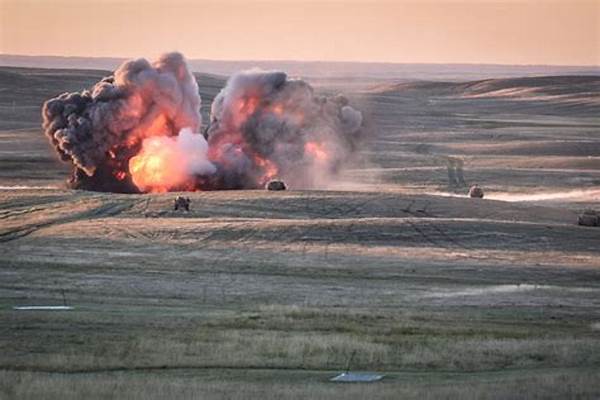The impact of war on natural landscapes is a profound issue that extends beyond the immediate toll on human life and infrastructure. Historically, the devastation wrought by armed conflict has left enduring scars on the environment, transforming verdant ecosystems into barren wastelands. This topic has gained increasing importance as global awareness of environmental preservation grows. Establishing a harmonious balance between development, security, and environmental stewardship remains a formidable challenge in regions plagued by conflict.
Environmental Degradation Due to Armed Conflict
The impact of war on natural landscapes often manifests through the immediate and long-term degradation of ecological systems. During warfare, deliberate or collateral destruction of forests, wetlands, and other ecosystems frequently occurs, driven by tactical necessities or as an inadvertent consequence of military operations. For instance, the use of chemical defoliants or incendiary devices in combat can result in vast tracts of land denuded of vegetation, disrupting the intricate balance of local biodiversity. Post-conflict, the lingering presence of landmines and unexploded ordnance poses further threats to natural landscapes, rendering the land unsafe for both humans and wildlife.
Moreover, warfare-induced environmental damage can exacerbate issues such as soil erosion, water pollution, and habitat fragmentation. These conditions hinder natural regeneration and diminish the capacity of ecosystems to provide essential services, such as clean air and water. The ramifications of this degradation are far-reaching, impacting food security and livelihoods, particularly for communities heavily reliant on agriculture and natural resources. Thus, the impact of war on natural landscapes not only compromises ecological integrity but also perpetuates a cycle of poverty and instability in affected regions.
Biodiversity Loss and Human Displacement
1. The impact of war on natural landscapes often leads to significant biodiversity loss. Destruction of habitats, both intentional and collateral, results in the depletion of flora and fauna, some of which may be endemic or endangered species.
2. Armed conflicts frequently force human populations to move, leading to further stress on natural landscapes. The impact of war on natural landscapes includes increased deforestation and resource depletion as displaced communities strive to rebuild their lives.
3. War-induced changes in land use patterns significantly alter local ecosystems. The impact of war on natural landscapes is evident where agricultural lands revert to wilderness or new settlement areas emerge, disrupting existing habitats.
4. Pollution resulting from military activities contributes to long-lasting damage. The impact of war on natural landscapes is profound as contaminants like oil, heavy metals, and unexploded ordnance disperse into the soil and water bodies.
5. Conflicts often disrupt conservation efforts, exacerbating the impact of war on natural landscapes. Ranger patrols and conservation programs may be suspended, giving rise to poaching and illegal logging activities in protected areas.
Economic Repercussions of Environmental Damage
The impact of war on natural landscapes bears significant economic repercussions that are often overshadowed by more immediate concerns. When ecosystems are degraded, the livelihoods of communities that depend on them are invariably affected. Agricultural productivity declines as previously arable land is rendered infertile by warfare. Water resources become tainted, affecting both human consumption and agricultural use, thereby compounding food insecurity in conflict and post-conflict regions.
Furthermore, opportunities for ecotourism, a potential revenue stream for many developing regions, are severely hindered. Natural landscapes that once attracted tourists for their scenic beauty and biodiversity are transformed into inhospitable and desolated areas. As these regions endeavor to return to peacetime conditions, the cost of ecological restoration adds an additional layer of financial burden, emphasizing the importance of incorporating environmental considerations into conflict resolution and peacebuilding processes.
The Impact of War on Soil and Water Resources
The impact of war on natural landscapes extends to the degradation of soil and water resources, essential components of sustainable ecosystems. Bombardments and military machinery can drastically alter the topography, leading to significant soil dislocation and erosion. Once the vegetative cover is lost, soil fertility diminishes rapidly, thwarting agricultural recovery efforts for years, and at times, decades.
Water resources, already scarce in many conflict zones, suffer contamination through military activities. Pollutants from explosives, chemicals, and fuel can leach into aquifers and river systems, leading to adverse health impacts for communities and disrupting aquatic ecosystems. This degradation necessitates comprehensive rehabilitation efforts and underscores the importance of safeguarding these vital resources from warfare’s destructive footprint.
Challenges in Rehabilitation and Conservation
Rehabilitating landscapes damaged by war poses considerable challenges, particularly in terms of funding, resources, and sustained political will. The impact of war on natural landscapes complicates restoration initiatives, often requiring extensive demining operations before ecological recovery can commence. Moreover, the complexities of balancing community needs with environmental conservation create additional hurdles in post-conflict scenarios.
Efforts to restore and conserve war-affected landscapes must align with socioeconomic priorities, integrating local communities into the recovery process to foster resilience and sustainability. Engaging in collaborative partnerships with international donors, NGOs, and local stakeholders is crucial to surmount these challenges and ensure that environmental rehabilitation supports long-term peace and development.
Implications for Future Conflict Resolution
Addressing the impact of war on natural landscapes is integral to any comprehensive conflict resolution strategy. Anticipating and mitigating environmental destruction can reduce the long-term ecological footprint of warfare. Future peace negotiations should incorporate environmental protection clauses, ensuring that conflicting parties commit to minimizing damage to the natural environment during hostilities.
Sustainable management of natural resources can also play a pivotal role in preventing conflicts. By safeguarding ecosystems and promoting equitable resource distribution, potential tensions over access and ownership are mitigated. Ultimately, incorporating environmental considerations into conflict prevention and resolution frameworks not only preserves biodiversity but also promotes lasting peace and stability.
The Human Role in Preserving War-Torn Landscapes
The impact of war on natural landscapes inevitably requires a concerted human effort for rejuvenation. Community engagement in environmental restoration projects can foster social cohesion, empowering individuals to take ownership of their landscapes and aiding in the recovery process. Educational programs focusing on sustainable practices can transform war-torn regions into examples of environmental resilience.
Furthermore, international collaborations are crucial in sharing expertise and resources, facilitating the exchange of best practices for land rehabilitation. By prioritizing initiatives that address the environmental impact of war on natural landscapes, societies can pave the way for effective conflict recovery and sustainable development.
Conclusion
In summary, the impact of war on natural landscapes is a multifaceted issue with ecological, economic, and social implications. The degradation of ecosystems during warfare undermines biodiversity, economic stability, and human health, necessitating comprehensive approaches to recovery. Addressing the environmental destruction caused by conflict is integral to achieving durable peace and development.
The preservation and rehabilitation of natural landscapes must become a priority in both conflict resolution and peacebuilding processes. By fostering international cooperation, engaging affected communities, and integrating environmental considerations into strategic planning, it is possible to mitigate the destructive legacy of war and promote a sustainable future for afflicted regions. The impact of war on natural landscapes, while significant, can be transformed into an opportunity for regeneration and growth.





